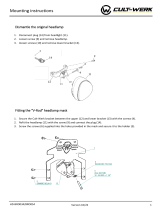
6
E60 Complete Vehicle
The side line is a logical extension of the front-end design. Thus the E60 is the first BMW
model not to have the previously typical side swage line. Its place is taken by a character
line, an edge of light which lends the side view a whole new character. Various light reflec-
tions above and below this line produce a play of light and shadow, thereby giving the
impression of a very low side panel.
The transition from the hood to the side panel occurs in the imaginary extension of the
character line.
TThhuuss tthhee EE6600 hhaass tthhee lloowweesstt ffrroonntt eenndd eevveerr ooff aannyy BBMMWW..
The sculpture-like
appearance of the side view is consolidated by the fact that there are no protective strips
in the door areas.
Despite its increased height, the passenger cell has a coupe-like appearance thanks to the
sweeping design of the C-pillar. Short overhangs and generously dimensioned wheel arch-
es accentuate the dynamic, bold overall appearance. The clear shaping of the wheel lips
as a typical BMW design element emphasize the wide track of the E60.
The rear end conveys an at once wide and compact effect due to the fact that there are no
visible joints. Under the high deck lid with integrated spoiler lies
tthhee bbiiggggeesstt lluuggggaaggee ccoomm--
ppaarrttmmeenntt iinn tthhee ccuurrrreenntt BBMMWW rraannggee..
The rear lights are mounted in brilliant optical hous-
ings, the tops of which are sloping in appearance.
The large rear apron of the E60 is subdivided by additional reflector elements and thus
gives the impression of being lighter.
A distinctive diffuser lip not only ensures opti-
mum aerodynamics but also reduces the
amount of dirt which accumulates on the vehi-
cle rear end.
The overall impression communicates an
unmistakable sense of the E60's power and
strength to road-users driving behind it.
KT-11014
KT-11016






















